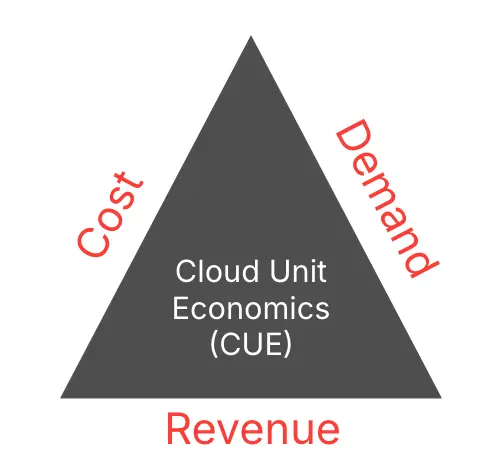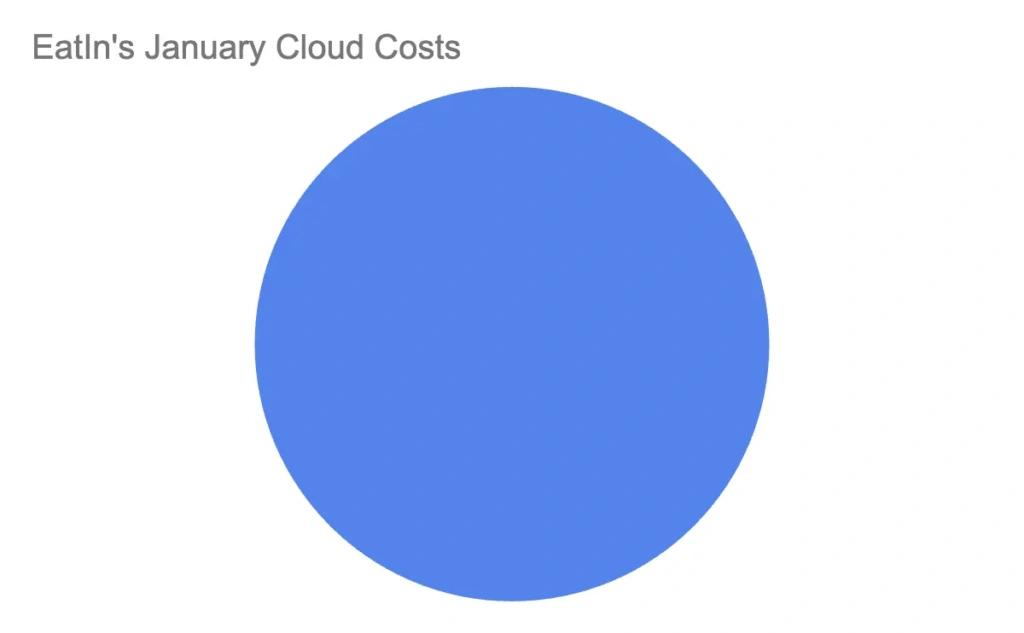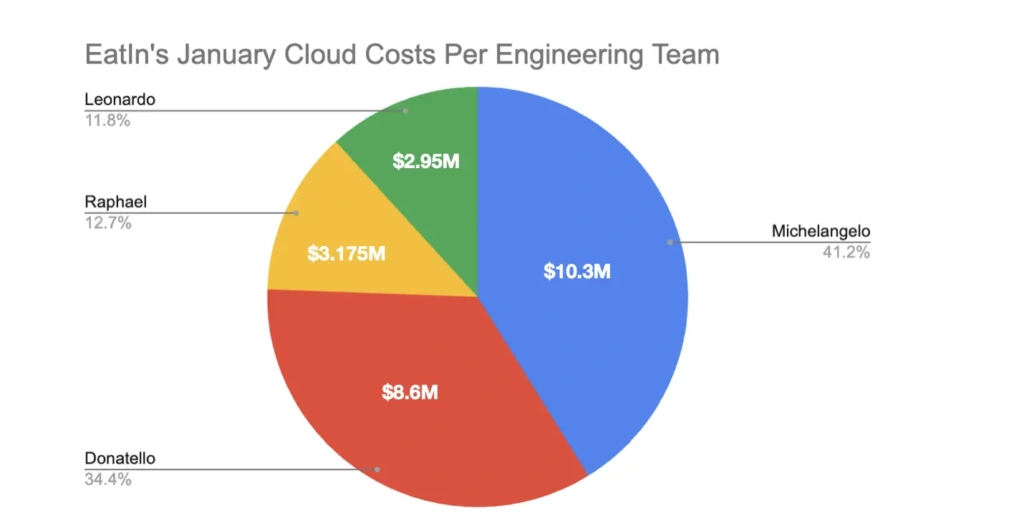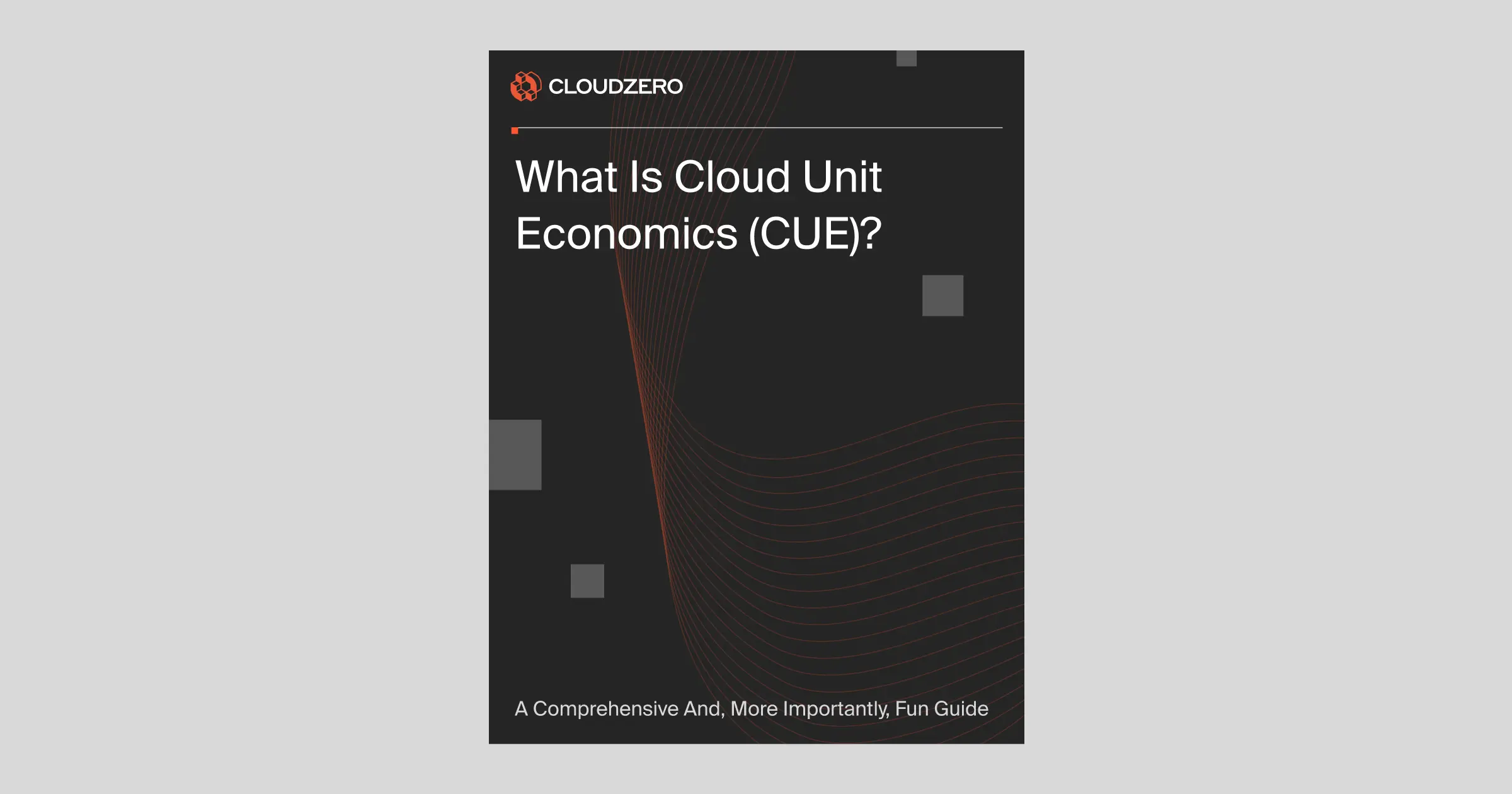1. Introduction
Welcome to CloudZero’s crash course on cloud unit economics (CUE)! It’s an exciting world, full of profit and revenue and other very cool economics terms, so we hope your seatbelt is securely fastened.
At its core, CUE is about measuring and maximizing cloud-driven profit. It compares cloud costs with demand and revenue metrics to show you how efficiently you’re spending in the cloud, how your efficiency has changed over time, and — with the right platform — the most impactful ways to improve your efficiency.
Knowing that you spent $650,000 on compute last month doesn’t tell you anything about how efficiently you’re spending. Even knowing that your costs went up (or down) by $25,000 last month doesn’t give you any concrete efficiency insights; an increase in cloud costs could be accompanied by an increase or decrease in cloud efficiency. The true value of CUE that it puts those raw cost figures in context — of demand, of revenue, of individual business units, etc. — to tell you whether your cloud spending is healthy or unhealthy.
Because it comes with a handful of complex-sounding terms, CUE may sound more complicated than it really is. In reality, CUE’s goals are simple: Assess what you’re spending on cloud-based products and features, how much your end-users are using those products and features, and how much revenue those products and features are generating. Cost, demand, revenue — the triumvirate of CUE.

To hammer this point home, here are the three types of data most commonly used when getting started with CUE:
- Cloud cost data — Data, typically in the form of cloud vendor billing statements, that shows where your cloud costs are going. You will use this data to produce cost allocations: cost per feature, per product, per customer, per team, per microservice, etc. — custom business buckets that mirror your business structure and drive ownership and accountability for every dollar of spend.
- Demand data — Data that shows how much your end users are consuming your products/features. The demand data you choose to track depends on your business’s core value offering. You will combine this data with cloud cost data to get unit cost metrics: a representation of your incremental cloud costs in terms of your central demand driver. If you’re a digital workout company, you’d track # of workouts; if you’re a food delivery app, you’d track # of orders; if you’re a shipping logistics company, you’d track # of shipments. Demand data usually comes from either internal apps/databases or third-party apps/databases like Amplitude, Snowflake, Datadog, and SumoLogic.
- Revenue data — Data that shows how much revenue individual products/features generate. You will combine this data with cloud cost data to calculate efficiency metrics like Cloud Efficiency Rate (CER).
That’s it. Once you’ve identified the best sources of this data and fed them into CloudZero, you’re all set.
2. Unit Cost Metrics: The Engine Of CUE
The central engine of CUE is the unit cost metric: a representation of your incremental cloud costs in terms of your central demand driver. Simply use your cloud cost management (CCM) platform to divide your cloud costs by your organization or team’s chosen demand driver — a record of how much customer demand you process in a given interval (e.g., # of orders, # of workouts, # of shipments, etc.) — et voila, unit cost metric.

Unit cost metrics are much easier to understand in practice than in theory, so let’s dive into an example.
Ex. 1: EatIn, A Food Delivery App
Imaginary food delivery app EatIn has a substantial cloud footprint ($300M/year), and they process 2 billion orders per year. As orders are at the heart of their business value, their unit cost metric looks like this:

When companies process this many units of demand, they often raise the denominator by several powers of 10 to get a more useful end figure. So, EatIn’s leadership team would likely prefer to track cost per 1,000 orders, thus:

$150 per 1,000 orders is EatIn’s unit cost metric, viewed at a level of yearly granularity. “Granularity” refers to your data’s level of detail; CloudZero can present cloud cost data at a level of hourly, daily, weekly, monthly, or yearly granularity. Typically, unit cost metrics yield the most useful data on somewhat larger timescales — so, for standard reporting purposes, EatIn would probably want to see Cost Per 1,000 Orders Per Month in a neat dashboard:
| Jan | Feb | Mar | Apr | May | Jun | Jul | Aug | Sep | Oct | Nov | Dec | |
| Cloud cost | $25M | $25.01M | $25.02M | $25.03M | $25.04M | $25.05M | $25.06M | $25.07M | $25.08M | $25.09M | $25.1M | $25.11M |
| # of orders | 160M | 180M | 200M | 220M | 240M | 260M | 280M | 300M | 320M | 340M | 360M | 380M |
| Cost per 1k orders | $156.25 | $138.94 | $125.10 | $113.77 | $104.33 | $96.35 | $89.50 | $83.57 | $78.38 | $73.79 | $69.72 | $66.08 |
As you can see in this chart, EatIn’s cloud costs increase steadily throughout the year, but this doesn’t stop their Cost Per 1,000 Orders from decreasing throughout the year. This means that EatIn’s demand is scaling at a higher rate than their cloud costs — a very happy state of affairs.
We’ve simplified the numbers to further illustrate the important point made earlier in this guide: When your cloud costs increase, it doesn’t necessarily mean your cloud efficiency decreases. If your cloud infrastructure was built efficiently — as EatIn’s clearly was — your unit costs can decrease even as your cloud costs increase. You may not scale at such an unbelievably efficient rate as EatIn, but this is how CloudZero customers measure their cloud efficiency. When cloud costs increase but unit costs decrease, it means healthy growth, efficient scaling, and more profit for you.

Source: FinOps Foundation
3. Combining Unit Cost Metrics With Cost Allocations
It’s important to understand the difference — and the relationship — between unit cost metrics and cost allocations. As we’ve seen, unit cost metrics divide a unit of consumption (in our case, cloud costs) by a unit of demand (in EatIn’s case, # of orders), and a string of unit cost metrics indicates how cloud-efficiently a company is scaling.
Cost allocations, on the other hand, divide an absolute cost into custom business buckets for showback/chargeback. So, if cloud cost is a pie, cost allocations would divide the pie into appropriately sized slices, based on a particular business lens. Allocating costs is a key step in calculating unit cost metrics — which we’ll get to in a second — so, the more accurate your allocation, the more accurate your unit cost reporting will ultimately be.
Time for another example — this time, with EatIn’s engineering teams.
Ex. 2: EatIn’s Cost Per Engineering Team
Let’s home in on EatIn’s January cloud costs, which the table above tells us was a flat $25M. Unallocated, the cost would look like this:

… a pretty useless chart. By “useless,” we mean “completely devoid of business insight.” On its own, a raw number representing cloud cost doesn’t tell you anything meaningful. And as we learned above, even a sequence of monthly cloud cost numbers wouldn’t tell you anything particularly meaningful. Only when cloud cost is put in a business context does it tell you anything meaningful about the condition of the business.
Cost allocations provide that essential business context. One common way to allocate costs is by engineering team, which shows you who’s consuming what portions of your overall cloud costs.
If EatIn were using some extremely sophisticated CCM platform — CloudZero, say — which could allocate 100% of their cloud costs, including IaaS, PaaS, and SaaS costs; shared, containerized, and multi-tenant costs; this is what their January Cost Per Engineering Team (teams which they’ve whimsically named after the Teenage Mutant Ninja Turtles) would look like:

Now we’re getting somewhere. From this chart, we see that team Michelangelo is responsible for the highest portion of EatIn’s January cloud costs — way more than teams Raphael and Leonardo.
This data leads us down the pathway to more informed, business-relevant questions. Questions like:
- Why is team Michelangelo incurring such high costs? Does the answer justify their costs (e.g., Are they working on EatIn’s flagship product/feature)?
- Is team Donatello building in some cost-efficient way that team Michelangelo could employ to lower their costs?
- Has team Leonardo achieved cloud efficiency nirvana?
The coup de grace is combining cost allocations with unit cost metrics. If EatIn had a year’s worth of Cost Per Engineering Team data, and they’d been calculating Cost Per 1,000 Orders during the same timeframe, they could combine these two data sources to get Cost Per 1,000 Orders Per Engineering Team — an extremely sophisticated view of how their engineering teams’ cloud efficiency is trending over time.
With the right platform, EatIn could get the same level of analytical sophistication for any business lens that was important to them. They could get cost per product, cost per feature, cost per customer, cost per microservice, and view them all in a context of Cost Per 1,000 Orders.
In other words: They could get a high-level sense of their business efficiency, tease it apart by any portion of their business making a meaningful impact on it, investigate what’s driving efficiencies/inefficiencies, make more informed, cost-efficient engineering decisions, uncover unprofitable customers, have internal discussions about adjusting pricing models, and track the impact of all of it over time.
This is exactly how the world’s most sophisticated cloud-driven companies use CloudZero. One company — a neobank valued in the tens of billions of dollars — tracks more than 40 unit cost metrics and more than 45 cost allocations to get a clear sense of how to drive greater cloud efficiency. Upstart used cost per product and cost per organization to drive engineering accountability and reduce their costs by $20M. Neon grew engineering engagement by 700% through allocations like cost per team and cost per customer.
4. Cloud Efficiency Rate (CER): The Crown Jewel Of CUE
All of the manipulations of cloud cost and demand data we’ve outlined so far are excellent for making detailed investigations into your business. Take an unallocated lump sum of cloud spend, allocate it in a business-relevant framework, assess its unit cost efficiency, and remediate areas of inefficiency.
The last piece of this puzzle is revenue. At the end of the day, we invest in the cloud because we believe it’s the best possible way to make the most possible money. But since AWS 1.0 hit the scene in 2006, there have been no unifying benchmarks by which companies can assess the efficiency of their cloud spending.
Yes, cloud spending factors into other SaaS metrics like COGS and gross margin. But given the outsized sums of money companies spend on cloud resources — it’s often a top-two or -three expense category for technology companies — we need a metric that isolates cloud costs and assesses them in the context of revenue.
CloudZero created the Cloud Efficiency Rate (CER) metric to do just this. At its most basic, here’s how you calculate CER:

Like gross margin, the formula yields a percentage that tells you how much of your revenue is and isn’t going to your cloud providers.
Ex. 3: EatIn’s Cloud Efficiency Rate
Let’s again look at some pretty simple numbers for our old friends, EatIn. Let’s suppose that their annual revenue is $1B and their cloud costs are $200M.

In this situation, EatIn would have a CER of 80% — far from elite (we’ll go over benchmarks in a moment). This means that for every $1.00 of revenue they generate, they send $0.20 to their cloud provider(s).
Now, let’s say that the next year, they start using CloudZero, find a slew of incredible efficiency opportunities, reduce their cloud costs by 30% (average year-one CloudZero customer savings), and continue raising their revenue.

Now we’re talking. A CER of 88.33% is still not quite elite, but it’s in much more rarefied company than 80%. An improvement like this doesn’t just look good in a board deck; like any meaningful SaaS metric uptick, it can whet investors’ appetites, boost valuations, and position companies well for public offerings.
5. So What’s A Good CER?
Naturally, you’d want to understand where companies fall along the spectrum of CER. In 2024, CloudZero partnered with BenchmarkIt, a B2B SaaS research firm to develop this spectrum. Here it is:
- 25th Percentile: 75% CER
- Median: 80% CER
- 75th Percentile: 92% CER
Want to see how you stack up? Use CloudZero’s CER widget.
Generally speaking, anyone in the top quartile of a SaaS metric like this is in elite territory. So, companies aiming for the top of the CER mountain should set a goal of 92% or above.
For reference, an analysis of CloudZero’s publicly traded customers (i.e., those whose revenue data is publicly available) showed a 95% median CER. This means that overwhelmingly, public CloudZero customers are in elite CER territory.
6. Going Deeper: Dimensionally Enriched CER And Layered CER
Understanding your overall CER is a great first step. But alone, overall CER is about as useful to engineering initiatives as gross margin is to finance initiatives — it can give you a sense of your overall efficiency, but it won’t highlight the most impactful savings opportunities.
So, it’s necessary to go one — or several — steps further. Like we did with unit cost metrics, we can combine CER with cost allocations (the cloud cost pie divided into appropriately sized slices) to get Dimensionally enriched CER and layered CER calculations.
Dimensionally Enriched CER
In CloudZero parlance, cost allocation buckets — cost per team, per product, per feature, per microservice, and per customer — can also be referred to as “Dimensions.” A Dimension is a business lens you can apply to your overall cloud spend. “Customer” is a common Dimension; when you apply it to your cloud spend, you see that spend in terms of cost per customer.
When CloudZero customers use this Dimension, they’re often surprised by what they see — their biggest customers may be unprofitable, one segment may cost substantially more than another segment, customer costs tend to spike at a particular time of day, etc. They then use those revelations to make intelligent changes to their infrastructure.
With a precise understanding of how much cost each customer is driving, and organizational knowledge of how much revenue each customer is driving, you could get the Dimensionally enriched CER metric: CER per customer.
Imagine EatIn has an enterprise line of business. They zero in on CER for two of their customers, both of whom use Kubernetes and share a storage bucket, but whose costs are accurately allocated thanks to CloudZero:
- Customer X has a contract of $1M/yr, and drives $700,000/yr of cloud cost
- Customer Y has a contract of $400k/yr, and drives $50,000/yr of cloud cost
Customer X’s CER is 30%, and Customer Y’s CER is a much friendlier 87.5%.
Taking it a step further, EatIn could get an average CER by dividing their revenue by the total cost attributable to their enterprise customers, and then compare every individual customer’s CER against this figure. This would show them how each enterprise customer’s CER compares to the average — who’s bringing it up, and who’s bringing it down.
This would reveal disparities of cloud efficiency, and illuminate the most impactful opportunities for EatIn to strengthen overall business efficiency.
Layered CER
You can take CER to an additional level of depth by leveraging another of CloudZero’s core differentiators: the ability to layer different allocations on top of one another for extremely nuanced understandings of business value drivers.
Real-world example
One of our customers, Beamable, is a video game platform company. The same way AWS provides cloud infrastructure for software companies to build and run their apps, Beamable provides video game infrastructure for game designers to build and run their games.
Beamable wanted a very sophisticated layered Dimension that required layering three individual Dimensions: cost per service per game per customer. In other words, how much each of a particular customer’s game’s individual services cost. Our customer success team developed some sophisticated allocation logic to deliver this.
With CER, they could connect these Dimensions to revenue at each stage of the calculation. Beamable could see their CER per service per game per customer, and understand exactly how much business value each of their customers’ individual games’ services were driving.
Of course, as every business has a unique business value framework, the layering potential for Dimensions and for CER is endless. Develop as many CER views as you want, and view your cloud-driven business value through any lens, at any time.
7. Conclusion
To recap, the foundations of CUE are:
- Unit Cost Metrics, which show you your cloud costs as a function of demand.
- Cost Allocations (a.k.a. Dimensions), which divide your absolute cloud costs into discrete business buckets for showback/chargeback.
- Cloud Efficiency Rate (CER), a SaaS metric which shows you your cloud costs as a function of revenue.
- Dimensional Enrichment, in which you combine unit cost metrics and/or CER with cost allocations to get more granular views of efficiency drivers.
And some useful CUE maxims:
- When your cloud costs increase, it doesn’t necessarily mean your efficiency decreases. What matters most are your unit cost metrics, which can rise, stay flat, or decrease as your cloud costs increase.
- Only when cloud cost is put in a business context does it tell you anything meaningful about the condition of the business. On its own, knowing that your overall costs are increasing, staying flat, or decreasing doesn’t tell you anything meaningful.
- Elite CER starts at 92%. CloudZero’s public customers average 95% CER, putting them comfortably in elite territory.
This all may sound complex. But the fact is, all of these are more or less traditional business efficiency practices that we’ve applied to a cloud context. The cloud has its own unique complexities, but that’s why CloudZero exists.
Day in and day out, we turn complex cloud spend environments into clean, clear, actionable accounts of business efficiency. Ready to embark on your CUE journey? Read the rest of this guide, and schedule a CloudZero demo today.
Further reading: “How To Calculate Unit Cost By Creating A Telemetry Stream”

